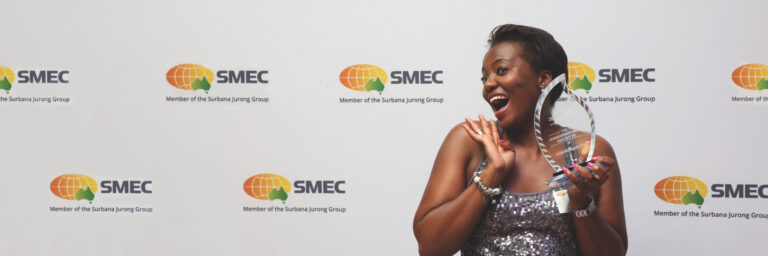

Challenging unconscious bias through education
At SMEC, we’re certainly on the right path, and I am proud of what we’ve achieved to date. I joined the company because its values align with my strong views regarding equality, justice and fairness. As CEO, I’m in a unique position to shape and drive equality in our organisation. My strong feelings about injustice have made fairness and equality a critical element of my leadership and a benchmark I use to measure my success in this role.
It’s a responsibility, but also very much a privilege of my position, to consciously and significantly affect change and provide structures and pathways to ensure women see and gain from better equality in the workplace. Education is crucial for success. But education is not solely about providing excellent programs and pathways for women. These are most definitely important, and we are proud of the many programs in place at SMEC. But for these initiatives to truly make the change, we need to create an entire network, an ecosystem of support for them to exist within.
We can start by acknowledging men and women, across all cultures, face different societal and professional challenges. There are foundational, ingrained differences in the ways cultures perceive genders, attributes and unspoken expectations on both males and females. These start developing from the day we are born, and they are implanted so deeply that more often than not we can’t see them for what they really are.
Taking this, albeit incredibly uneven and discombobulating terrain, our foundation for gender equality discussions has to be the starting point. It’s impossible to know all the nuances and understand the myriad of existing unconscious biases; that’s an impossible task, but acknowledging that they exist, setting the trigger to start looking out for them, and then genuinely listening when people tell their stories or explain their struggles becomes possible. It’s a never-ending process of questioning, listening, learning and then, making informed choices. We must try to view context and accommodate differences without bias as it’s the only way to build a workplace community of tangible and accountable support networks. And if we do that, we can reduce the bias even further, eventually to the point where we start to get a self-solving system. In light of this overwhelming complexity, what steps can our business and our leaders take to address workplace equality and truly champion female leadership? Unconscious bias, by nature, is an underlying force that is tricky to detect. To address it, we must be proactive in seeking it out. Businesses must provide a framework for addressing inequality in all its forms; they must provide training and workshops, encourage open conversations, and foster a culture of active listening and safe spaces to have meaningful discourse. Success will also require a willingness in the individual to be reflective, somewhat vulnerable, and challenge some of their own ingrained biases.
SMEC runs regular workshops around unconscious bias, particularly with our senior leaders, and we always need to do more. These sessions can sometimes be uncomfortable, and there is a critical balance between being firm and vulnerable. What I’ve learnt over the years is that addressing bias isn’t a blame game, it can’t be, as we all have them. It’s about questioning and unpacking our expectations, pondering why we approach certain situations the way we do, and asking ourselves if our approach has the potential to be exclusive to others, despite our best intentions. Many of our leaders have been genuinely shocked when they finally see what is really going on, the part they play, but also pleasingly, the power they have suddenly gained to address the inequality that exists as a result.
Workplace equality and the genuine ability for women to thrive equally with their male counterparts will happen organically when it’s a goal that both men and women work toward. But perspectives must be heard fairly and freely for us to reach that goal. As CEO, it is my responsibility to facilitate this workplace culture, but it’s not always straightforward. One of the more challenging and uncomfortable things about being a leader is calling out poor ingrained behaviours.
It’s not about creating some advantage for women, it’s about creating fairness where it doesn’t currently often exist in the first place. And this change, whilst leading from the top, must take place at all levels of the organisation.
For me, I try hard to take the time to understand why someone may hold fast to outdated views. Start by asking the question; what led you to make that decision? What was your rationale in that instance? And continually ask “Why” to dig deeper into those hidden underlying thought patterns. In my experience, most people behave in a way that they genuinely believe is best and without malice. So, it all comes back to education and shining a light on bias while providing a safe space to challenge the status quo.
A deliberate and strategic approach to diversity
SMEC is continually learning, listening and refining our approach to gender equality in the workplace. Our strategy is focused on four primary areas; leadership accountability, the talent pipeline, building SMEC’s capabilities and creating flexible, inclusive and diverse people practices. I aim to ensure our entire team endorses and fosters a corporate culture of recognition and support.
Tackling unconscious bias, deliberately seeking out invisible obstacles and sometimes addressing truths that make us uncomfortable is how we create the genuine foundation for females to thrive in leadership roles.
We have equality targets at SMEC, which must be included in any businesses approach to gender parity, including a 50% target for female graduates. Internally we’ve established the Fusion program – a technical mentorship initiative aimed at building technical consulting skills and connecting mentees‹ with mentors, with a requirement of 50/50 gender participation. SMEC also employs straightforward solutions including parental leave, genuinely flexible work arrangements, and pay parity, for which we have undertaken an internal study four years in a row. We also take every opportunity to learn from our external partners. We’re active members of Consult Australia’s Champions of Change Coalition program, of which I am an ambassador. I am proud that in 2020 the Workplace Gender Equality Agency recognised SMEC in Australia as an Employer of Choice for Gender Equality, and that they reaffirmed this in 2021. And we are now up to our 2nd year of participation in Cultivate – our sponsorship program exclusively focused on sponsoring female leadership within SMEC so as to ensure we have a more even playing field of opportunity.
Our industry must reflect our society, its make-up and its needs, and a vital component of this is gender diversity. For me, education and a willingness not just to listen, but to hear, is critical. Tackling unconscious bias, deliberately seeking out invisible obstacles and sometimes addressing truths that make us uncomfortable is how we create the genuine foundation for females to thrive in leadership roles. Education and awareness unlock growth, form a solid foundation of understanding and foster a workplace culture that encourages individual accountability. When we achieve all this, then we will reap the benefits of a genuinely equal workplace.
Related
insights
 IWD2022: Women at SMEC shine bright
IWD2022: Women at SMEC shine bright
Seven inspiring and influential women who work at SMEC, Logashri Sewnarian, Libby Paholski, Pawitasari Fransisca, Florence Wambugu, Raveena Grover (pictured), Karina Discaya and Saima Bodla, champion International Women’s Day 2022.
 What advice would you give your younger self? SMEC’s women in engineering reflect on their career journeys
What advice would you give your younger self? SMEC’s women in engineering reflect on their career journeys
Reflecting on Women’s Month in South Africa, SMEC South Africa celebrates their very own women in engineering - inspiring females who are not only transforming our built environment but leading the way for the next generation of female engineers.






